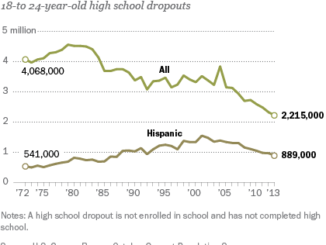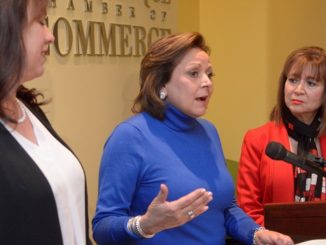
by Richard Whitmire
Texans maintain they’ve been on a roll ever since 1901, when oil was discovered at Spindletop Hill. Perhaps. But when it comes to charter schools, there’s a more recent roll taking place that may rival Spindletop.
Dramatic changes are happening after a decade when Texas charters “lost their swagger and went on autopilot,” as one charter network founder put it. Now, the swagger appears to have returned.
Skeptical? Consider these developments:
On Wednesday, Valero Energy Foundation announced a $8.4 million gift to pay for 14 KIPP-trained college guidance counselors for San Antonio ISD.
Why is this big? Because this is the tip of what could spread nationally: deep-pocket funders who have long been wary of giving to traditional school districts eager to jump in when the cause is a college success collaboration between charter networks that have pioneered these programs and traditional districts just sticking their toes into that water.
In August, the Texas legislature passed a bill that for the first time would give charters facilities money. The amount, $60 million, isn’t enough to cover more than some modest repairs, but the principle is important and may have national impact: Shouldn’t legislatures fund schools, including facility expenses, based on their effectiveness rather than on whether they are traditional or charter?
That’s not the only pro-charter legislation to emerge recently. In the spring, lawmakers offered traditional districts a huge incentive to partner with charters. Not only do they get a boost in funding, but they also get a two-year reprieve from state sanctions if the schools are low-performing.
That action, the two-year reprieve, hasn’t drawn a lot of attention, even within Texas. But the odds that the reprieve could blossom into a major player in the coming years are significant. What district isn’t looking for a breather on schools they can’t turn around?
Behind much of this is the Texas District Charter Alliance, a group of charters and districts that agreed on common goals.
Rio Grande Valley–based IDEA Public Schools is poised to make a dramatic statement on expanding with quality.
Fueled by a recently announced $85 million federal grant, IDEA appears likely to meet its 2022 goal of running 173 schools that enroll 100,000 students, up from its current 61 schools that enroll 36,000 students. Next year, IDEA will add 18 new schools, and another 18 the following year.
Growing at a rate that few charter networks dare, IDEA has kept student success high by hewing to a tight, never-changing replication model. If IDEA can do it, why not others?
The student outcomes at Texas charters have improved in recent years, partly (or mostly) because of a state law passed in 2013 (SB2) that forced closures of low-performing charters.
In the first year under that new law, 60 charters were closed, compared with 47 in the three years before. That may explain why Stanford’s CREDO (Center for Research on Education Outcomes) found that over the past three years, Texas charters added the equivalent of 17 more days of reading instruction per year (measured against their district peers). There was no change in math.
“Texas is indeed on a roll,” said Nina Rees, president of the National Alliance for Public Charter Schools, “because of changes made to its state law through SB2 that place a greater premium on quality — both to close bad schools and offer high performers a fast-track application process to replicate.”
Or, as KIPP co-founder “big dog” Mike Feinberg put it succinctly: “We tended our garden, pulled the weeds, and gave tender loving care for the flowers to bloom.”
The growth in demand for charters in Texas appears to be relentless.
Seven years ago, there were 119,600 students in Texas charters; last year there were 272,700. IDEA is not the only fast-growing network there; in Houston, KIPP’s student population just grew by 8 percent, up to 13,346 students, while YES Prep Public Schools grew at the same rate, up to 10,258 students.
Harmony Public Schools has 33,500 students in 54 schools. Uplift Education has 16,000 students on 17 campuses in the Dallas–Fort Worth area. Smaller cities, such as El Paso, that in recent years had few charter options are suddenly seeing interest from major charter networks.
And still, there aren’t enough seats for parents who want in. Across the state, there are 130,000 students on waiting lists.
Charter-district collaborations in Texas outpace those in other states.
The United for College Success collaboration has emerged as a national model for others to copy. The group is a mix of charters and traditional school districts, all trying to boost the college success rates of its alumni. With the recent addition of Emerge, the college success program at Houston ISD, the group has gained major clout that can be wielded during negotiations with colleges to provide more support for their first-generation alumni.
One interesting discussion item within this group right now: How can charter networks (and possibly traditional districts as well) share the considerable burden of making on-campus checks on their alumni, an important part of ensuring those alumni will walk away with degrees?
Couldn’t a charter network based in Houston check on alumni from other networks attending college in that city, while a Dallas-based charter does the same there? Intriguing idea, especially with the number of charter alumni continuing to grow. In the years to come, what gets worked out here could become the norm everywhere.
This is just a short list of developments in Texas, a list that doesn’t even include the new common application for charters in Houston, where parents can apply to five charter networks using a single application form.
Why Texas? Why now?
Let’s start with “Why Texas?” One reason is that Texas has four charter powerhouses — IDEA, YES Prep, KIPP, and Uplift Education — that are very much interwoven by a mix of talent and shared ideas, as described in The Founders. Houston is the birthplace of KIPP, and YES Prep’s founder, Chris Barbic, once roomed with the KIPP founders while they were all in Teach for America. Barbic helped give IDEA an early boost, and both KIPP and YES were role models for IDEA.
Having all four of those networks in one place injects creative juices not found in most states.
Another factor: Texas is home to Spring Branch ISD, where in 2013 former superintendent Duncan Klussmann did something radical: As told in On the Rocketship, Klussmann investigated nearby charters — KIPP and YES Prep — that were succeeding with low-income minority students and moved to fold them into the district, offering KIPP shared space at one middle school, YES at another. Parents could choose either track, charter or traditional.
Today, the program has expanded into high school. Not only do parents have the option of the charter programs, but all students benefit from the college success programs pioneered by the two networks.
What Klussmann did broke the ice in Texas, which explains the growing acceptance of charter/district alliances in other cities, especially around college success.
Part of the “Why Now?” question is answered above. It took time for Klussmann’s innovation to spread to normally wary superintendents. And it took time for the Texas legislature to recognize the benefits of collaborations and give districts financial incentives to form partnerships. It took IDEA years to determine that its model, if replicated precisely, could expand at a rapid pace.
Another part of the answer goes back to the passage of SB2. That law sparked a radical shake-up of Texas charters that took four years to show results.
But perhaps the biggest, and least acknowledged, reason is that four years ago Feinberg left his role as KIPP’s superintendent of Houston schools to assume the big-think role of co-founder, giving him time to work behind the scenes to create many of the organizations described above. His fingerprints are all over these developments — and the striking number of traditional school districts willing to partner with charter networks, especially on college success.
It’s hard to overstate the significance of what happened Wednesday in San Antonio. For years, foundations have been reluctant to contribute to traditional school districts — but college success programs may prove to be the exception, especially if done in collaboration with charter networks that have invested years in designing these initiatives for their alumni.
For Texas charters these days, there’s a lot less autopilot and a lot more swagger.
Richard Whitmire is the author of several books, most recently “The Founders: Inside the Revolution to Invent (and Reinvent) America’s Best Charter Schools.” Whitmire is a member of the Journalism Advisory Board of The 74.



